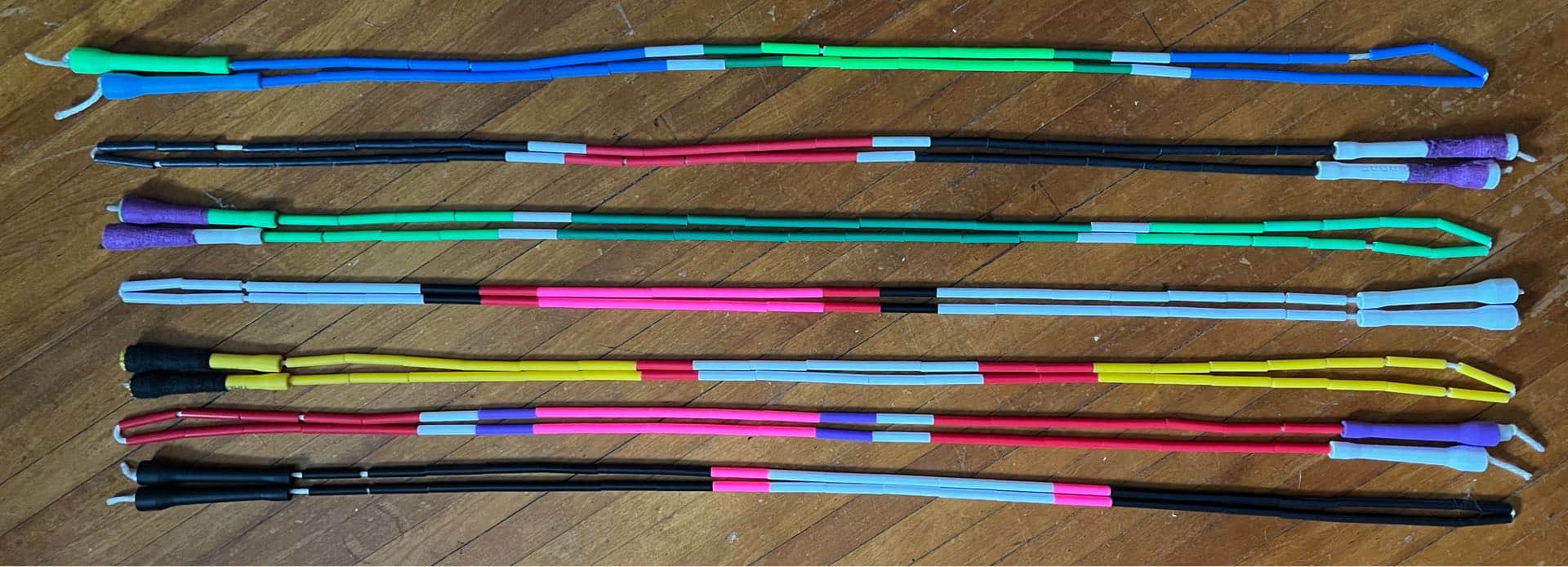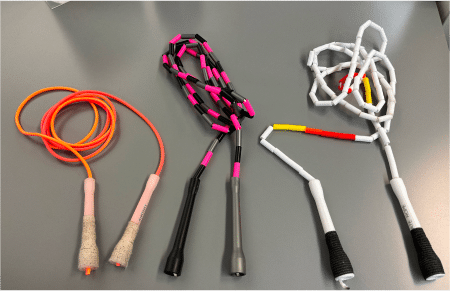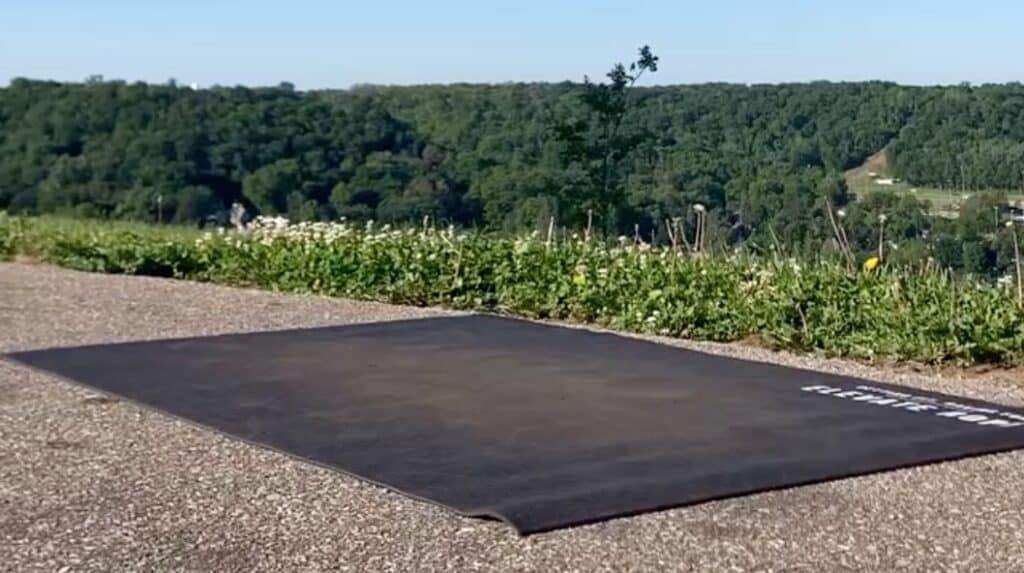
Jumping rope is one of the most enjoyable and effective ways to stay fit and active, but like any skill, it comes with its challenges. Whether you’re just starting out or looking to refine your technique, having some key jump rope tips can make all the difference.
Drawing from my own experience, advice from my coach, and wisdom from seasoned jumpers in the community, I’ve compiled eleven essential tips to help you navigate your jump rope journey.
These tips aim to make your practice smoother, safer, more enjoyable, and ultimately more rewarding.
1. Choose the right jump rope
Select a rope that suits your height and skill level.
Beginners may find a beaded rope easier to control, while speed ropes are great for advanced jumpers. You can also get wire ropes for speed, but these niche ropes aren’t great for learning the basics – they’re all about speed.
I use many different types and brands of jump rope, and you can see some of them on my gear page.
Understanding your goals
Choosing the correct jump rope begins with understanding your fitness goals. Are you looking to improve cardiovascular endurance, build strength, work on coordination, or simply have fun while staying active?
Different ropes serve different purposes, and knowing what you want to achieve can guide you toward the best option. For instance, a speed rope with a thin, lightweight design is ideal if your goal is speed and agility.
On the other hand, if you’re focusing on strength and endurance, a weighted rope that challenges your muscles may be more suitable.
Defining your objectives will help narrow the choices and ensure you select a rope that aligns with your fitness journey.
Considering jump rope materials and handles
The rope’s material and the handles’ design are crucial factors in selecting the best jump rope for you.

Ropes are made from various materials, including PVC, leather, beaded segments, or steel cable coated with nylon.
Each material offers different benefits—PVC ropes are versatile and durable, making them great for beginners, while leather ropes provide a smooth, traditional feel and are often favored by boxers.
Beaded ropes offer rhythmic feedback, making them perfect for beginners or those practicing tricks.
Handles also vary in design. Ergonomic handles with a comfortable grip prevent hand fatigue during longer sessions.
Some ropes have ball bearings in the handles, allowing for smoother rotations, which is particularly useful for speed and double-unders.
I recommend beaded ropes for those just starting out and those trying to learn tricks because they provide the weight and feedback needed to learn effectively. Plus, once you master a skill with the beaded rope, you’ll feel like a superhero when you try it with a speed rope.
And, if you’re feeling crafty, you might try the DIY approach and build your own jump rope.
Testing your jump rope
Test out different ropes to see what feels best for you whenever possible.
If you have access to a fitness store, a Meetup, or a community of jumpers, trying out various ropes can provide valuable insight into what works for your style and needs. Talking to jumper friends about what works for them can also help.
Pay attention to how the rope feels in your hands, the weight distribution, and how smoothly it turns.
Remember, the best jump rope feels comfortable, allows you to perform your desired moves with ease, and ultimately enhances your overall jumping experience.
2. Proper jump rope fit
Ensure your rope is the correct length. The length of the rope is vital and can significantly impact your jumping experience. A rope that is too short or too long can hinder your performance and even lead to frustration.
Most new jump ropes will come with sizing instructions, and I recommend checking them out.
The optimal length of your jump rope can be affected by your:
- height
- style
- skill level
- goals
Measuring your jump rope length
To measure your rope, stand on the center of the rope and raise the handles up as far as they go.
For beginners, the handles should reach your nipples or armpits or slightly below. This helps maintain proper form and efficiency.
If your rope reaches your shoulders, it’s too long. When ropes are too long, they force you to hold your hands further out so you don’t trip on the rope. This can result in fatigue and shoulder injuries.
This measurement is a good starting point, but personal preference also plays a role. Some skippers prefer a slightly shorter rope for faster spins, while others opt for a longer rope for more room to execute tricks. It’s also worth noting that many modern ropes are adjustable, allowing you to fine-tune the length to your liking.
The more advanced you get, the shorter you may want your rope to be. I size my rope so that the handles, when held horizontally, align with my belly button. This makes my rope about 84” long without handles and about 94” long with handles.
This may be too short for some folks, but for me, it’s perfect and helps encourage better form by helping me keep my elbows in and focus on rotating at the wrist rather than the shoulder.
It also makes sizing new ropes really easy since I know my optimal length.
3. Warming up for jump rope
Always warm up your muscles before starting your jump rope session. Simple dynamic stretches or a few minutes of light jogging can prevent injuries.
Warming up before any physical activity is essential; jumping rope is no exception. A proper warmup prepares your body for the intense, repetitive jumping motion, reducing the risk of injury and improving performance.
When you jump rope, your calves, Achilles tendons, and feet are under significant stress, so it’s crucial to gradually increase your movements’ intensity.
A good warmup increases your heart rate and blood flow to the muscles and activates the nervous system, enhancing coordination and reaction time.
Skipping the warmup can lead to strains, sprains, or more severe injuries, particularly if you plan a high-intensity or extended session.
Take it from me – a guy who has caused severe self-injury by neglecting warm-ups. It’s always worth the time to warm up. It’ll help prevent injury and make your jump session smoother.
Effective jump rope warm-up techniques
A thorough jump rope warmup should include dynamic stretches, mobility exercises that target the lower body, and some light aerobic activity to get your heart pumping.
Start with ankle circles, calf raises, and gentle lunges to loosen up the joints and muscles you’ll be using. Then, follow this with a few minutes of light, low-impact jumping, keeping the jumps small and the pace steady.
Starting slow helps to gradually acclimate your body to the motion and rhythm of the rope. You can also incorporate exercises like leg swings, hip circles, and walking toe touches to improve flexibility and range of motion, vital for smooth and effective jumping.
My jump rope warm-up routine
I almost always start with an intermediate warm-up routine I learned from Lauren Jumps’s Fancy Feats app.
In short, I do three to six repetitions of:
- Lunges
- Arm circles, forward and backward
- Hip openers
- Wrist rotations
- Hamstring stretch into a squat, continuous
- Ankle rotations
- Standing oblique side to sides
- Chest openers
I also frequently throw in a few sets of
- Situps
- Push-ups
- Crunches
- Other calisthenics
Incorporating jump rope drills and exercises
Once you’ve completed your warmup, it’s time to move on to more specific jump rope exercises.
Begin with basic jumps, focusing on maintaining a steady rhythm and keeping your jumps low to the ground to conserve energy.
As you become more comfortable, you can progress to more challenging drills, such as double-unders, where the rope passes under your feet twice with each jump, or criss-crosses, which involve crossing and uncrossing the arms while jumping.
Alternating foot jumps and side swings are excellent exercises for improving footwork and agility. Incorporating these drills into your routine enhances your jump rope skills and provides a comprehensive cardio workout that targets multiple muscle groups.
4. Correct posture for jumping rope
Keep your head up, back straight, and shoulders relaxed. Bend your knees slightly and jump on the balls of your feet to reduce impact.
Maintaining good posture while jumping rope is crucial for performance and injury prevention. Proper posture ensures that your body moves efficiently, reducing unnecessary strain on your muscles and joints.
The foundation of good posture begins with your alignment: your head should be up, your eyes looking forward, and your shoulders relaxed, not hunched.
Keep your chest open and your core engaged; this will help stabilize your body and control your movements. Maintaining a neutral spine—neither overly arched nor rounded—creates a strong base that allows you to jump easily and reduces the risk of lower back pain or discomfort.
Lower body alignment and jumping technique
The alignment of your lower body is equally important for good posture during jump rope exercises.
Keep your knees slightly bent to absorb the impact of each jump. Ensure your jumps are light and controlled, with only a small lift off the ground—just enough for the rope to pass under your feet.
Your feet should land softly on the balls of your feet, with heels slightly elevated, to minimize the impact on your joints. Avoid landing flat-footed or letting your knees lock, as this can lead to unnecessary strain and potential injury.
By focusing on these aspects of your lower body alignment, you can maintain good posture and jump more efficiently.
Consistency and body awareness
Good posture develops with practice and awareness. As you jump, regularly check in with your body to ensure you’re maintaining proper alignment.
If you feel fatigued or notice your form slipping, take a break and reset your posture before continuing. Consistently practicing good posture will improve your jump rope technique and contribute to better overall body mechanics, making you less prone to injury and more capable of sustaining longer, more intense sessions.
Over time, good posture will become second nature, allowing you to focus more on your performance and less on correcting your form.
5. Jump rope hand and wrist movement
Use your wrists to turn the rope, not your arms. Small, quick movements will help maintain a steady rhythm and conserve energy.
Your arms and hands play a significant role in maintaining good posture while jumping rope.
Keep your elbows close to your body, forming roughly a 90-degree angle at the elbows. This positioning helps minimize excessive movement and keeps the rope turning efficiently.
Your hands should be slightly in front of your hips, with wrists relaxed and doing most of the work to turn the rope. Avoid swinging your arms too widely or letting your hands drift away from your body, as this can disrupt your rhythm and lead to fatigue.
Proper arm and hand positioning helps maintain good posture and enhances your rope speed and control.
6. Consistent timing for jumping rope
Focus on maintaining a consistent rhythm. Count your jumps or use music to keep a steady pace to improve your coordination and endurance.
When working with new timing, jumping without the rope and tapping out the rhythm on your legs can be helpful.
The importance of timing in jump rope
Timing is a fundamental aspect of jump rope that directly impacts your rhythm, coordination, and overall performance.
Proper timing allows you to synchronize your jumps with the rope’s rotation, ensuring smooth and efficient movement. When your timing is on point, each jump feels effortless, and you can maintain a consistent rhythm for extended periods.
Conversely, poor timing can lead to frequent missteps, tripping on the rope, or unnecessary fatigue as you spend more energy correcting your movement. Good timing is essential for performing basic jumps, double-unders, or more advanced tricks.

Building timing through practice
Developing timing in jump rope requires consistent practice and a focus on the fundamentals.
Start by slowly and steadily practicing a basic jump to build a strong foundation. Pay close attention to the sound of the rope hitting the ground, and aim to jump just as the rope reaches its lowest point.
This auditory cue is crucial in helping you establish a rhythm. As you become more comfortable, gradually increase your speed while maintaining control.
Count your jumps or use a metronome or music (my favorite) to help keep a consistent pace. The goal is to internalize the rhythm so that your body naturally syncs with the rope’s rotation, making your jumps more fluid and controlled.
Incorporating drills to enhance jump rope timing
To further improve your timing, incorporate specific drills into your jump rope routine.
One effective drill is the “side swing and jump,” where you swing the rope to one side without jumping and then jump on the next rotation.
This exercise helps you practice timing your jumps with the rope’s movement. Another helpful drill is “single leg jumps,” where you alternate jumping on one leg at a time. This challenges your timing and coordination, as you need to stay balanced while keeping the rhythm consistent.
Additionally, practicing double-unders—where the rope passes under your feet twice per jump—can significantly enhance your timing skills, as it requires precise synchronization of your jump height and rope speed.
Staying patient, persistent, and positive
Developing excellent jump rope timing requires patience and persistence. Struggling with timing is normal, especially when learning new techniques or increasing your speed.
The key is to stay focused on the rhythm and not get discouraged by mistakes. Regular practice and a conscious effort to maintain a steady pace will lead to gradual improvements.
As your timing improves, you’ll find that you can perform more advanced moves with greater ease and confidence. Remember, consistency is critical—good timing will become second nature over time, transforming your jump rope sessions into a seamless, enjoyable experience.
It can be easy to get discouraged when you can’t pull off that super-slick trick, but it’s important to keep calm and positive.
I know from experience that showing up consistently and practicing means I will eventually nail that trick, so I focus on how grateful I am that I can jump, dance, and breathe, and I keep pushing.
Even when it feels like I’m not making progress, I am.
7. Start slow when jumping rope
Begin with basic jumps and gradually increase the intensity and complexity of your routines. Mastering the basics builds a strong foundation for advanced tricks.
My jump rope coach, @alwaysghadi, advocates practicing the basics each session, including basic jumps and rope work.
Finding the right duration for your jump rope practice sessions
The length of your jump rope practice sessions plays a significant role in your progress and overall enjoyment of the activity.
The ideal duration can vary depending on your experience level, fitness goals, and the intensity of your workouts.
For beginners, shorter sessions of 10 to 15 minutes are often sufficient to build endurance, improve coordination, and develop essential skills without overwhelming the body. These shorter sessions allow you to focus on mastering the fundamentals while minimizing the risk of fatigue or injury.
As you become more comfortable with jumping, you can gradually increase the duration of your sessions, adding a few minutes each week.
Balancing intensity and endurance
For more advanced jumpers, practice sessions might extend to 20 to 30 minutes or even longer, depending on the intensity and goals of the workout.
If you focus on high-intensity interval training (HIIT) or specific drills like double-unders or footwork combinations, your sessions might be shorter but more intense. They are often broken into intervals with rest periods in between.
Conversely, if you’re working on building endurance, longer, steady-paced sessions can help you achieve that. It’s essential to listen to your body and balance pushing your limits and avoiding overtraining.
The key is to ensure that your practice sessions are challenging enough to promote growth without leading to burnout or injury.
The role of consistency in jump rope training
Consistency is crucial in jump rope practice, and shorter, more frequent sessions are often more effective than infrequent, longer ones.
Daily or near-daily practice, even for a few minutes, can significantly improve technique, timing, and overall fitness.
Shorter sessions also make maintaining focus and proper form easier, reducing the risk of developing bad habits or experiencing burnout.
Over time, as your skills and endurance improve, you may extend your sessions’ length. The key is to establish a routine that you can sustain in the long term, ensuring continuous progress and enjoyment.
Adapting to your goals and schedule
The length of your practice sessions should also be adaptable to your schedule and goals. If you’re training for a specific event or working on a new skill, you might opt for longer, more focused sessions.
Conversely, shorter sessions might be more appropriate if you’re integrating jump rope into a broader fitness routine or using it as a warm-up or cool-down.
The flexibility of jump rope practice is one of its most significant advantages—you can tailor the duration and intensity of your sessions to fit your needs and lifestyle, making it a versatile and sustainable form of exercise.
8. Jump rope breathing technique
Practice controlled breathing. Inhale through your nose and exhale through your mouth. Steady breathing helps maintain endurance and focus.
The importance of breathing in jump rope
Breathing might seem like a secondary concern when you’re focused on mastering jump rope techniques, but it plays a crucial role in your performance and endurance.
Proper breathing techniques help to maintain a steady rhythm, reduce fatigue, and ensure that your muscles receive the oxygen they need to keep you jumping efficiently.
When your breathing is erratic or shallow, you’re more likely to tire quickly, lose focus, and even disrupt your timing, leading to mistakes and possible frustration.
Breathing correctly while jumping rope can significantly enhance your stamina and make your sessions more enjoyable.

Coordinating breathing with jumping rope movement
The key to effective breathing while jumping rope is coordinating it with your movements.
A common technique is to sync your breaths with your jumps, exhaling as you jump and inhaling as you land. This rhythm helps keep your breathing controlled and prevents you from holding your breath, which can lead to quick exhaustion.
For example, if you’re performing a series of basic jumps at a moderate pace, you might find a natural rhythm by breathing in for two jumps and out for two jumps.
As you progress to more complex moves like double-unders or criss-crosses, you may need to adjust your breathing pattern to accommodate the increased intensity. The goal is to keep your breathing steady and consistent, matching your jumping pace.
Diaphragmatic breathing for enhanced rope skipping endurance
One advanced breathing technique that can be particularly beneficial for jump rope is diaphragmatic breathing, also known as belly breathing.
This method involves engaging the diaphragm to take deeper, more efficient breaths rather than shallow breaths that only fill the upper chest. To practice diaphragmatic breathing, focus on expanding your abdomen as you inhale, allowing your lungs to fill completely, and gently contracting your abdomen as you exhale.
This technique increases oxygen intake and can help maintain energy levels during more prolonged or intense jump rope sessions. By training yourself to breathe deeply and consistently, you can delay the onset of fatigue and improve your overall endurance.
Staying mindful and relaxed
In addition to coordinating your breathing with your jumps, you must stay mindful and relaxed while jumping rope.
The number one thing I say to myself when practicing is, “relax, Diz, relax . . .” Then I take a few deep breaths, shake it out, and continue.
Tension in your body, especially in the shoulders and neck, can restrict your breathing and lead to unnecessary strain. Keep your shoulders relaxed and grip the rope lightly to promote better breathing.
If you start to feel out of breath or tense, take a moment to reset—slow down your pace, focus on deep, controlled breaths, and then gradually pick up the rhythm again.
Developing this awareness of your breathing will enhance your jump rope performance and contribute to a more enjoyable and sustainable practice.
Sometimes, if I’m having trouble letting go or relaxing, I’ll sit down, focus on my breathing, and meditate for 5 to 15 minutes to reset. Usually, that’s all I need to get back in the groove of easier breathing and skipping.
9. Jump Rope Footwear
Wearing supportive athletic shoes with good cushioning will reduce the risk of injury and discomfort during jump rope sessions.

The importance of footwear in jumping rope
Footwear is crucial for jump rope performance. It provides the necessary support, cushioning, and stability to protect your feet and lower body.
Since jumping rope involves repetitive impact on your feet, the right shoes can help absorb shock and reduce the risk of injury, such as plantar fasciitis, shin splints, or ankle sprains.
I’ve had all three injuries, and they’re no picnic!
The wrong footwear or jumping barefoot on hard surfaces can lead to discomfort and long-term damage, especially during intense or extended sessions.
Therefore, selecting appropriate shoes is essential to ensure that your jump rope workouts are effective but also safe and comfortable
Key features to look for in jump rope shoes
When choosing footwear for jumping rope, there are several key features to consider.
Cushioning is one of the most critical aspects, as it helps absorb the impact of each jump. Look for shoes with ample cushioning in the midsole, particularly in the heel and forefoot areas.
However, the shoes shouldn’t be overly cushioned, as too much padding can reduce stability and hinder your ability to feel the ground, which is crucial for maintaining good form.
Lightweight shoes are also preferable, as they allow quick, agile movements without weighing you down. Additionally, a low heel-to-toe drop shoe can promote a more natural foot position and improve your balance during jumps.
Stability and support for optimal performance
Cushioning, stability, and support are critical factors in selecting the right footwear for jumping rope.
The shoes should provide a secure fit, with a snug heel and enough room in the toe box to allow your toes to splay naturally. Good arch support is essential, especially if you have flat feet or high arches, as it helps maintain proper alignment and reduces strain on your feet and lower legs.
The outsole should offer sufficient grip and traction to prevent slipping, particularly if jumping on a smooth surface. A durable, flexible sole allows for smooth transitions and quick pivots, essential for executing more advanced jump rope techniques.
Footwear for different jump rope styles
Different styles of jump rope workouts may require slightly different footwear considerations. For example, suppose you’re focused on speed and agility, such as in double-unders or freestyle jumping. In that case, a minimalist shoe with a flexible sole and minimal padding might be ideal, as it allows for faster, more precise movements.
Conversely, if you’re incorporating jump rope into a broader high-intensity workout or performing jumps on harder surfaces, you might prefer a cross-training shoe with more cushioning and support.
It’s also worth noting that some jumpers prefer to jump in specialized athletic shoes, such as boxing or dance shoes, which provide a combination of stability, grip, and flexibility suited to their specific needs.
As an amateur shuffler, I’m quite partial to Fuego Dance Sneakers.
They have flat soles that are perfect for shuffling and provide enough cushioning and support for long skipping sessions.

Listening to your feet
Regardless of the footwear you choose, listening to your body and making adjustments as needed is essential.
If you experience discomfort, pain, or excessive fatigue in your feet, legs, or lower back, it may be a sign that your shoes are not providing the support or cushioning you need.
Experimenting with different brands, styles, and fits can help you find the perfect pair for your jump rope routine.
Additionally, it is important to replace your shoes regularly, especially if you jump frequently, to ensure they continue offering the protection and performance you need.
Use a jump rope mat

If you can afford a jump rope mat, I highly recommend getting one. It’ll extend the life of your ropes and help your knees and ankles by absorbing some of the impact.
10. Rest and recovery
Listen to your body and take breaks when needed. Allow adequate recovery time between sessions to prevent overuse injuries and improve performance.
Just as warming up is essential, cooling down after your jump rope session is equally important. A cool-down lets your heart rate gradually return to normal and helps prevent stiffness or soreness the next day.
Slow your pace and transition into light, low-intensity jumps before finishing with static stretches. Focus on stretching the calves, hamstrings, and Achilles tendons, which are heavily engaged during jumping.
Holding each stretch for 20-30 seconds can aid muscle recovery and flexibility. Listen to your body and give it the time to recover to maintain a sustainable and enjoyable jump rope routine.
The vital role of rest and recovery in jump rope
Rest and recovery are essential to any fitness routine, and jump rope is no exception. While jumping rope is an effective way to build cardiovascular endurance, strength, and coordination, it also places significant stress on your muscles, joints, and connective tissues, especially in the lower body.

Without adequate rest, your body doesn’t have the time to repair and strengthen these tissues, leading to overuse injuries such as shin splints, tendonitis, or plantar fasciitis.
Incorporating regular rest days into your jump rope routine allows your muscles to recover, reduces the risk of injury, and ultimately leads to better performance over time.
Rest days are the part of jumping I dislike most. I want to jump all the time, but I’ve learned the hard way that taking a day or two off can make my jumping days much more productive, fun, and pain-free.
Enhancing performance through recovery
Recovery isn’t just about preventing injury; it’s also about enhancing your overall performance.
During rest periods, your body repairs the microscopic damage to muscle fibers caused by intense exercise, leading to stronger, more resilient muscles. This process, known as hypertrophy, is crucial for building endurance and improving your jump rope skills.
Furthermore, rest helps replenish glycogen stores in your muscles, which are depleted during exercise. Without proper recovery, your energy levels may decrease, and you might find it harder to maintain the intensity and duration of your workouts.
By prioritizing rest, you ensure you’re physically and mentally prepared for each jump rope session, allowing you to train more effectively and achieve your fitness goals.
Active recovery and its benefits
In addition to complete rest days, incorporating active recovery into your routine can be highly beneficial.
Active recovery involves engaging in low-intensity activities, such as walking, gentle stretching, or yoga, that promote blood circulation and help flush out metabolic waste from your muscles.
These activities keep your body moving without putting additional strain on the muscles and joints used during jump rope sessions.
Active recovery can reduce muscle soreness, improve flexibility, and maintain your overall fitness level on days when you’re not jumping rope. It’s a valuable tool for keeping your body in optimal condition while allowing essential recovery time.
I’m quite partial to yoga, as it provides active recovery benefits and focuses on good breathing techniques and stretches.
Listening to your body
The most critical rest and recovery aspect is learning to listen to what your body is telling you.
Everyone’s tolerance for exercise varies, and it’s essential to recognize when your body needs a break. Signs that you may need more rest include persistent muscle soreness, fatigue, decreased performance, or a lack of motivation.
Ignoring these signs can lead to burnout or injury, slowing your progress. By tuning into your body’s signals and respecting the need for rest, you create a balanced approach to your jump rope training that supports long-term success and sustainability.
Remember, rest isn’t a sign of weakness—it’s a critical part of becoming a stronger, more skilled jumper.
11. You do YOU
Scrolling around on social media, we see people of all skill levels, many of whom are way more advanced. From one angle, seeing people pulling off wild tricks can be discouraging when you struggle not to trip over the rope.
I’ll admit to watching more than one video and thinking either:
“I can’t wait to be able to do that!”
or
“I’m pretty sure I’ll never be able to do that!”
At one point, I commented on a fellow jumper’s Instagram post about how I couldn’t wait to grow up so I could jump like she did. She gave me a terrific jump rope tip: I shouldn’t use her as my measuring stick – my jumping is my jumping, and her jumping is hers. And that’s just fine.

The only person I need to compete with is myself. The easiest way is to show up for practice regularly, dance like a maniac, skip like it’s going out of style, pay attention to my body, and rest when needed.
Some jumpers love wrangling their rope, while others rocket through double-unders or other tricks, and some are in it to raise their heart rate. Each one of these is a perfect reason to skip rope. You find what works for you and do you.
When I show up, I get better, even when I can’t see it. It’s cumulative, and it’s magic.
When I patiently work on a skill, I get better.
When I participate in the community, I get better.
I do me. You do you. 🙌🏼 We’ll get better!
Conclusion
I hope you’ve found these jump rope tips helpful and that they help you enjoy more effective and enjoyable workouts.
Please feel free to contact me with any feedback.
Happy hopping!
Get Dizzy!
Subscribe and get my top tips for skipping success.
